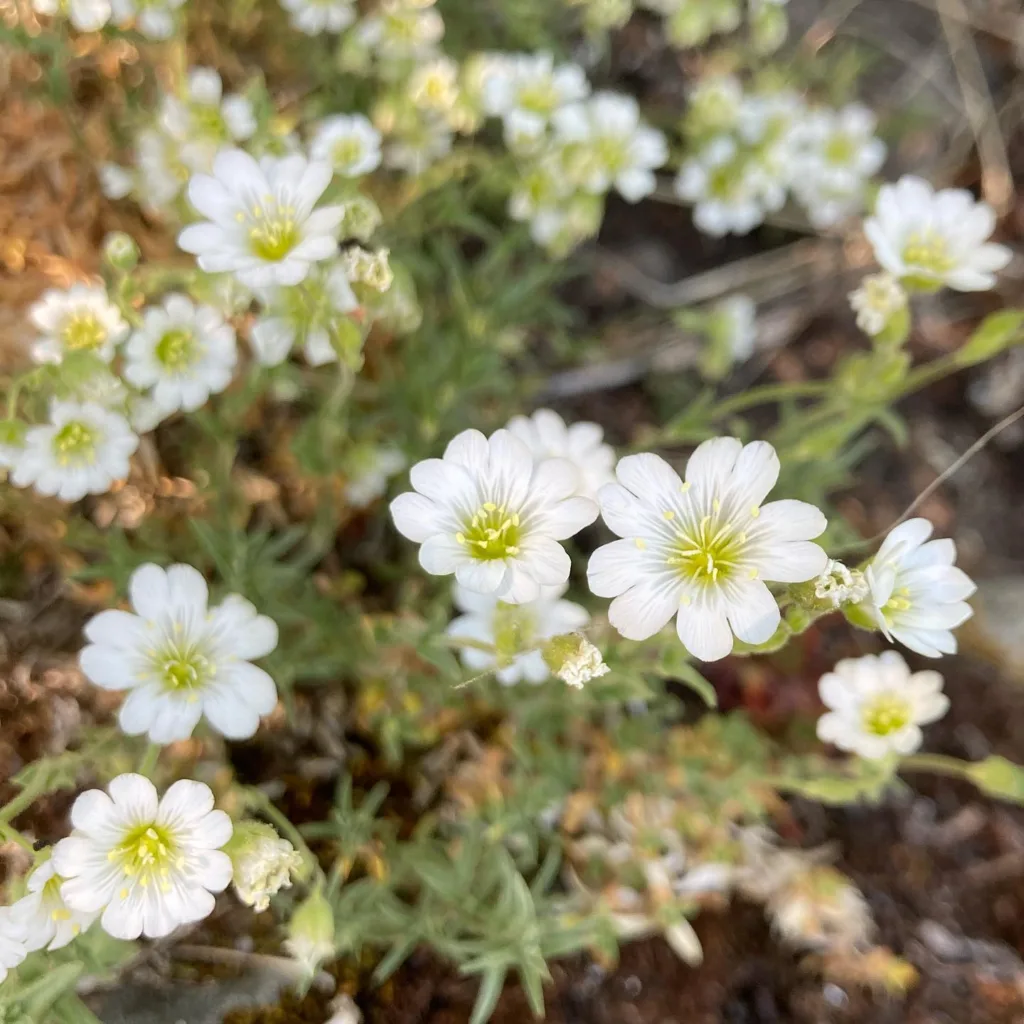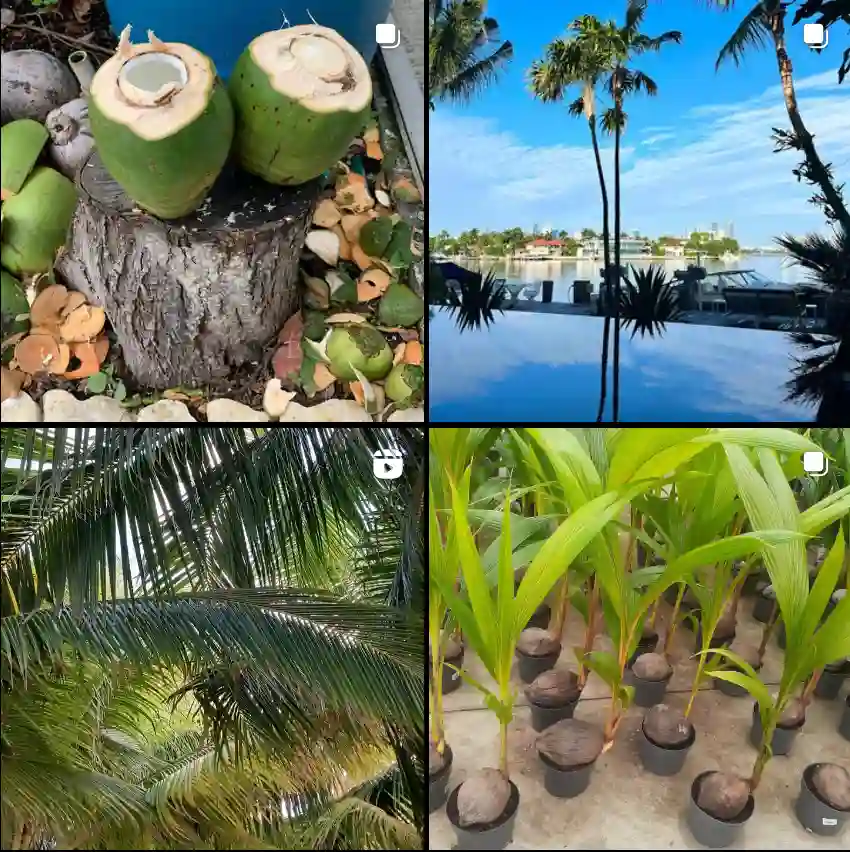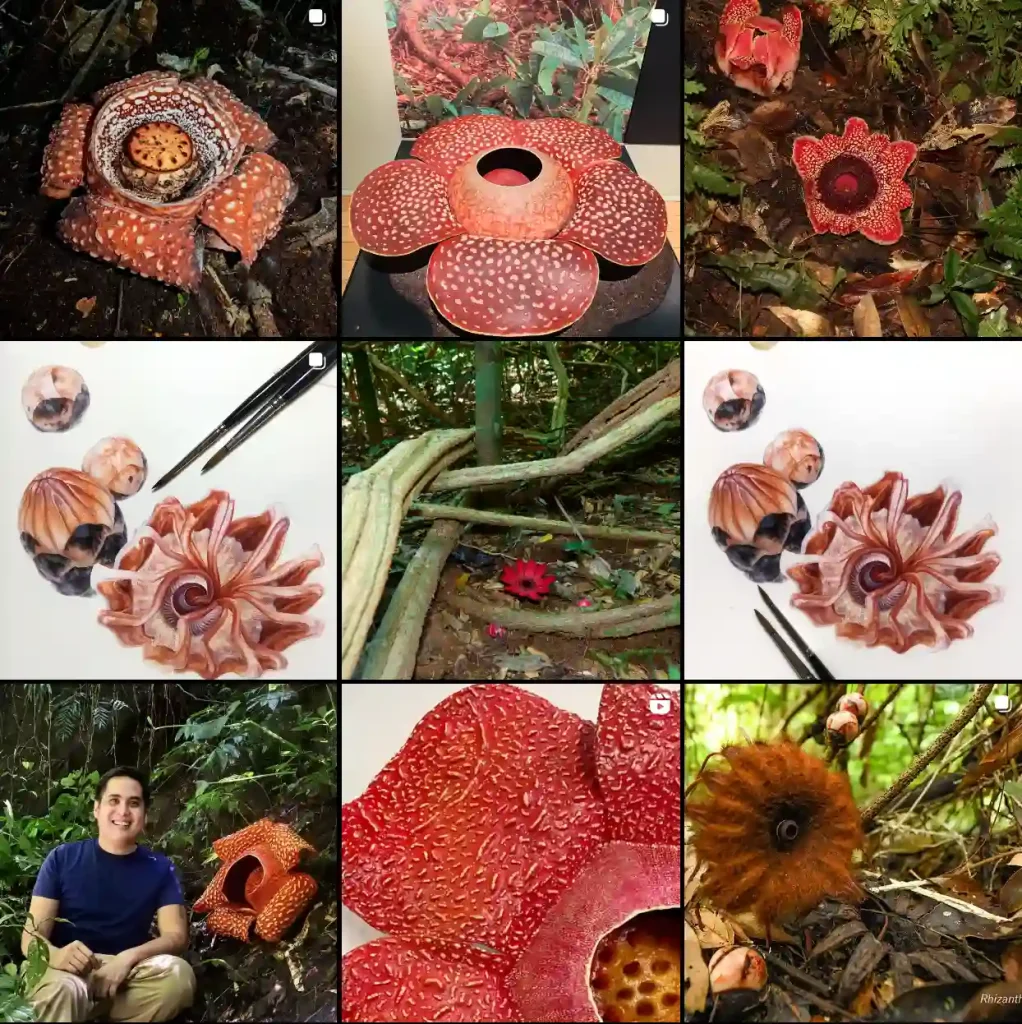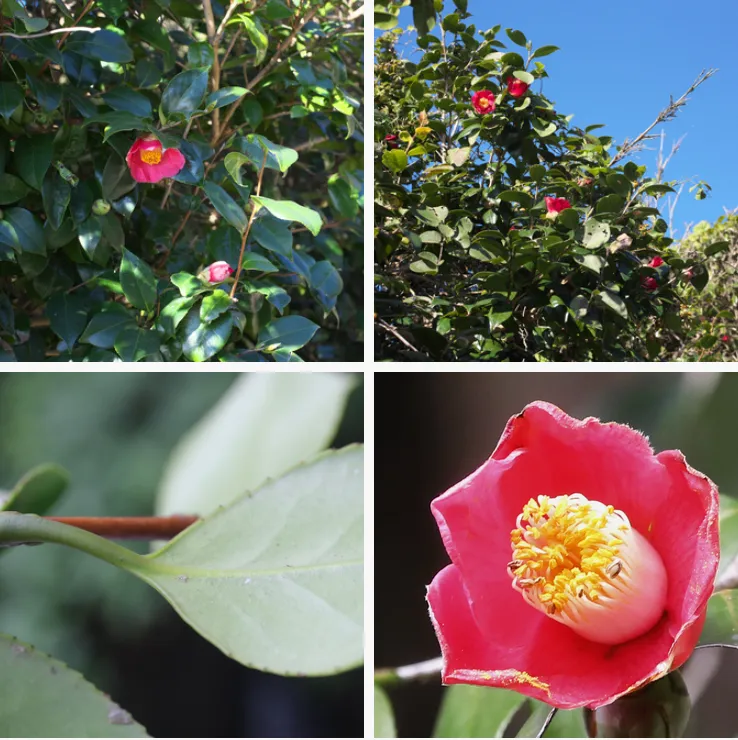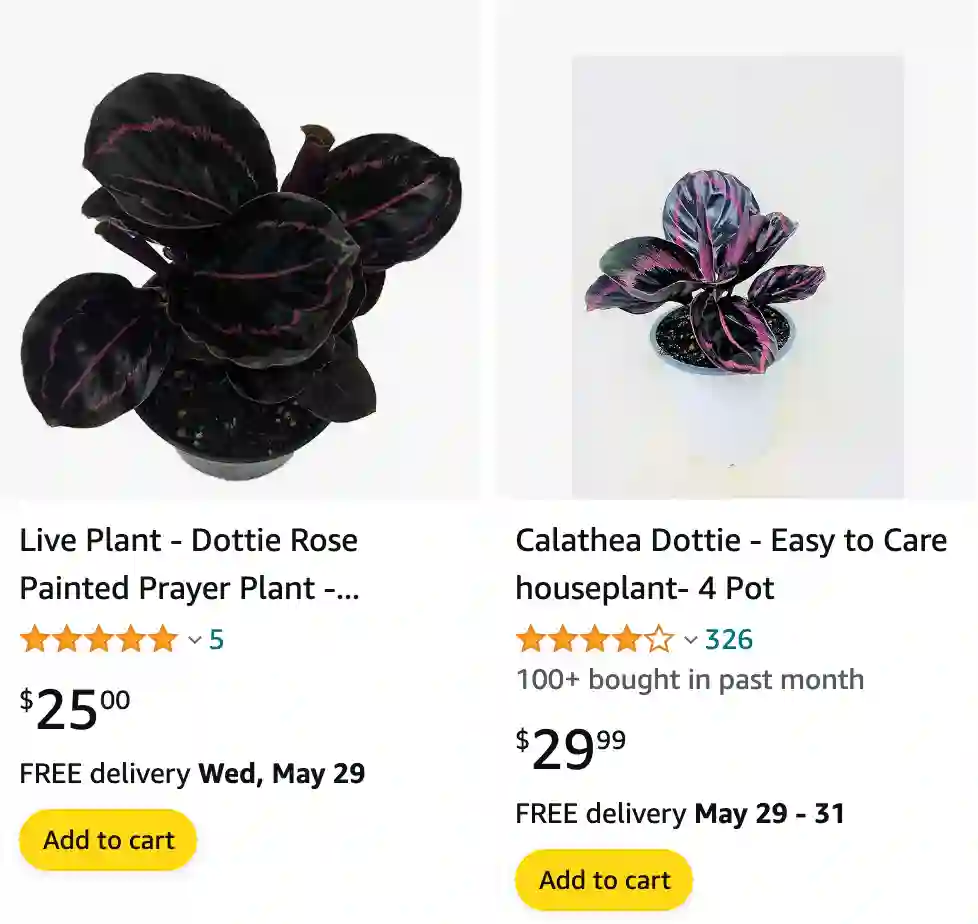
Introduction: Unveiling the Calathea Dottie – A Living Masterpiece
The world of houseplants offers an endless array of botanical wonders, but few capture the imagination quite like the Calathea. Celebrated for their vibrant, intricately patterned foliage, these tropical beauties bring an undeniable touch of the rainforest indoors. They are often referred to as “living plants” due to their unique, dynamic leaf movements, a captivating spectacle that unfolds throughout the day. Among the diverse species and cultivars, the ‘Calathea Dottie’ stands out as a true masterpiece. Its deep, dark green to almost black leaves, dramatically contrasted by striking hot pink stripes and subtle tinges of black, immediately command attention, setting it apart as a highly decorative and visually arresting specimen.
The Calathea Dottie, like many of its kin, has earned a reputation among plant enthusiasts for being somewhat “high-maintenance” or even a “drama queen”. This characteristic, rather than being a deterrent, often serves as an engaging challenge for those who delight in mastering precise plant care. The plant’s sensitivity to its environment underscores the rewarding nature of providing the exact conditions it needs to flourish. When its specific requirements are met, the Dottie responds with unparalleled vigor and beauty, making the effort profoundly worthwhile. Its primary appeal lies almost entirely in its stunning foliage, as its flowers, though present, are typically small and inconspicuous. This emphasis on leaf aesthetics positions the Calathea Dottie not merely as a plant, but as a dynamic piece of living art, capable of enhancing interior spaces and appealing to a broader audience interested in home decor and biophilic design.
In this comprehensive guide, readers will embark on a journey to understand and nurture the Calathea Dottie. We will delve into its botanical background, explore the essential care practices required for its thriving health, and provide practical solutions for troubleshooting common issues. Uniquely, this report also offers a “time-lapse” narrative, sharing the intimate journey of growing a Calathea Dottie from a small, unassuming plant to a mature, majestic specimen. With the knowledge contained herein, cultivating this exquisite plant can transform from a perceived challenge into a deeply satisfying experience, rewarding any dedicated plant enthusiast with its unparalleled beauty and dynamic presence.
Botanical Roots: Where the Dottie Comes From
Understanding the origins and scientific classification of the Calathea Dottie is fundamental to providing optimal care, as its natural habitat profoundly influences its needs in a domestic setting.
Classification: Marantaceae Family, Genus Calathea (Goeppertia)
The Calathea Dottie belongs to the Marantaceae family, commonly known as the “arrowroot family”. This diverse family also includes other popular genera cherished by houseplant enthusiasts, such as Maranta (often called Prayer Plants), Stromanthe, and Ctenanthe. While traditionally recognized under the genus
Calathea, many species, including Calathea roseopicta ‘Dottie’, have undergone reclassification and are now botanically categorized under the Goeppertia genus. This reclassification reflects ongoing scientific understanding of plant relationships but does not change the plant’s common name or its fundamental care requirements. The shared family lineage explains why these plants often exhibit similar characteristics, such as their striking foliage and specific environmental preferences.
Native Habitat: Tropical Rainforests of Central and South America – Understanding its Natural Environment
The Calathea Dottie’s ancestral home is the tropical rainforests of Central and South America, particularly the shaded, warm, and humid forest floors. In these environments, they thrive under the dense canopy of taller trees, receiving filtered or indirect light rather than harsh, direct sunlight. This natural setting is the blueprint for its indoor care. The plant’s inherent need for consistent warmth, high humidity, and diffused light is not merely a preference but a direct evolutionary adaptation to its native conditions. Replicating these conditions indoors is not just a recommendation; it is the core principle behind successful Calathea cultivation. This direct link between its origins and its care requirements explains why deviations from these conditions often lead to the plant’s characteristic “drama” or visible distress, such as browning leaf edges or curling foliage.
Physical Characteristics: Detailed Description of its Distinctive Dark Foliage, Vibrant Pink Stripes, and Unique Leaf Movement (Nyctinasty)
The Calathea Dottie is primarily admired for its extraordinary physical attributes, particularly its foliage:
- Foliage: The leaves of the ‘Dottie’ are truly captivating. They are typically glossy and round, emerging initially green before maturing into a deep, dark green that can appear almost black. This dark canvas is then dramatically adorned with prominent hot pink stripes and subtle tinges of black, creating a stunning contrast. The undersides of the leaves often display a rich burgundy color, adding another layer of visual interest. While the ‘Dottie’ itself has smooth, glossy leaves, the broader Calathea genus exhibits a variety of leaf textures, ranging from smooth to velvety.
- Growth Habit and Size: Calatheas are evergreen perennials that grow from rhizomes, exhibiting a clumping growth habit. The Dottie typically has thin stems and maintains an upright spreading habit. At maturity, the plant can reach a height of 15 inches to 3 feet (30-90 cm) and spread between 12 to 24 inches (30-60 cm). Its relatively coarse texture distinguishes it from other houseplants with finer foliage.
- Flowers: Although the Dottie is cultivated primarily for its stunning foliage, it does produce small, inconspicuous flowers, typically white and purple, during the warmer months. These blooms are often overshadowed by the plant’s striking leaves.
- Nyctinasty (Leaf Movement): One of the most fascinating features of Calatheas, including the Dottie, is their unique leaf movement, a process known as nyctinasty. During the day, their leaves unfurl and flatten to maximize light absorption, and as evening approaches, they fold upwards, resembling hands clasped in prayer. This movement is facilitated by a specialized joint located in the stem. It is important to clarify that while this “prayer-like” movement is characteristic of Calatheas, the common name “Prayer Plant” technically refers to Maranta leuconeura, a close botanical cousin, though Calatheas certainly exhibit a similar captivating daily ritual.
A Time-Lapse Journey with My Calathea Dottie: From Tiny Sprout to Grand Display
My journey with the Calathea Dottie began a little over a year ago. I remember walking into the nursery, drawn immediately to a small, unassuming 4-inch pot. The leaves, already a deep, almost velvety black, were just beginning to show hints of those vibrant pink pinstripes. It was a juvenile plant, likely around 6 months old, with perhaps four to six leaves, each no more than a few inches long. I named her “Midnight Bloom” for her dark allure and the promise of unfolding beauty.
Month 1-3: The Delicate Beginning and First Unfurling
Bringing Midnight Bloom home, I knew I was in for a challenge. Calatheas have a reputation for being finicky, but I was determined to provide the perfect environment. I placed her in a spot with bright, indirect light, several feet from an east-facing window, ensuring no direct sun would scorch her delicate leaves. I made sure the air around her was consistently humid, using a small humidifier nearby and misting her leaves daily. I watered her carefully, allowing the top inch of the peat-based soil to dry out before giving her a thorough drink, always with distilled water to avoid any leaf burn from tap water chemicals.
Within the first month, I noticed a subtle change: a tightly rolled new leaf emerging from the center. It was a tiny, hopeful tube, dark and mysterious. The unfurling process was a slow, deliberate dance, taking several days. I learned that low humidity can sometimes cause leaves to struggle or come out wonky , so I redoubled my efforts with the humidifier. By the end of the second month, that first new leaf had fully unfurled, revealing its stunning, crisp pink stripes against the dark backdrop. It was a moment of pure joy, a clear signal that Midnight Bloom was happy in her new home. She pushed out another leaf within the third month, confirming her slow but steady growth rate.
Month 4-9: Maturing Form and Root Expansion
As Midnight Bloom settled into her new routine, her growth became more consistent. I observed her leaves performing their nightly “prayer” movement, folding upwards as darkness fell and unfurling with the morning light. This daily ritual was a constant reminder of her living nature. Around the six-month mark, she had grown noticeably, now boasting a minimum of eight to twelve leaves, and her height had increased to about 5-7 inches. I started to notice roots peeking out from the drainage holes of her 4-inch pot, a clear sign she was becoming pot-bound.
Repotting can be a stressful event for Calatheas, so I chose a warm, humid spring day to minimize shock. I carefully removed her from the pot, gently loosening the root ball to assess its density. The roots were indeed filling the pot, a healthy white and firm. I moved her into a 6-inch pot, just one size up, with fresh, well-draining soil mixed with perlite and coco coir to ensure good aeration and moisture retention. After repotting, I kept her soil consistently moist and maintained high humidity, and within a week or two, she showed signs of recovery, pushing out new growth again. During this period, I began a monthly feeding schedule with a diluted, balanced houseplant fertilizer during the spring and summer months, as she was actively growing.
Month 10-12: The Established Beauty and Propagation Potential
By her first anniversary, Midnight Bloom was a truly magnificent specimen. She had reached a height of about 10-12 inches, with a spread of similar size, and was densely packed with over sixteen vibrant leaves. Her “upright spreading habit of growth” was evident, creating a lush, bushy display. She was now a “medium” to “large” plant, a testament to consistent care. I continued to prune any older, yellowing leaves to direct the plant’s energy towards new, healthy growth.
It was around this time that I considered propagation. Calatheas are best propagated by division, especially during repotting in early spring. While Midnight Bloom wasn’t due for another repotting just yet, I knew that when the time came, I would be able to gently separate her root clumps, ensuring each new section had its own healthy roots and at least one leaf. This method is the most effective for these clumping plants, allowing for the expansion of one’s Calathea collection. The thought of sharing her beauty with friends by creating new ‘Dottie’ plants was exciting. Midnight Bloom had transformed from a delicate sprout into a grand display, a living testament to the rewards of patient and attentive plant care. Her daily leaf movements, her vibrant patterns, and her consistent growth made her a true living masterpiece in my home.
Essential Care Guide: Nurturing Your Calathea Dottie
Caring for a Calathea Dottie involves creating an environment that closely mimics its native tropical rainforest habitat. While it has a reputation for being particular, understanding and consistently meeting its needs will ensure a thriving, beautiful plant.
Light: The Right Illumination for Vibrant Foliage
Calathea Dottie thrives in bright, indirect light. As an understory plant in its natural habitat, it is accustomed to filtered sunlight, not direct sun. Direct sunlight is detrimental; it can scorch the delicate leaves, causing them to fade, develop brown or tan patches, or even burn. Conversely, too little light can dull the vibrancy of its distinctive patterns and slow its growth. The ideal placement is near an east or north-facing window, or several feet away from a south or west-facing window, possibly with the aid of sheer curtains to diffuse intense light. The plant performs well in light levels between 1000 and 2000 ft-c. Strong artificial light can also be a suitable alternative.
Watering: The Art of Consistent Moisture
Consistent moisture is key for Calathea Dottie, but it’s crucial to avoid waterlogging, as this can lead to root rot. The general rule is to water when the top 25% to 1 inch (2-3 cm) of the soil feels dry to the touch. Watering frequency will vary with season and light conditions; less water is needed in winter, and brighter spots dry faster. Always water thoroughly until liquid drains from the bottom, and promptly discard any excess water from the saucer to prevent the plant from sitting in standing water.
A critical aspect of Calathea watering is water quality. These plants are highly sensitive to the chemicals commonly found in tap water, particularly chlorine and fluoride. Exposure to these chemicals can cause leaf tips and edges to turn brown, often with a yellowish hue. To mitigate this, it is highly recommended to use distilled water, rainwater, or filtered water. If tap water is the only option, allowing it to sit out overnight in an open container can help dissipate chlorine. This attention to water quality is a subtle yet significant factor in maintaining the plant’s vibrant foliage and overall health, demonstrating that even seemingly minor environmental elements can have a profound impact on a sensitive plant.
Humidity: Replicating the Rainforest Atmosphere
High humidity is non-negotiable for the Calathea Dottie, ideally between 50-60% or higher. Low humidity is a primary cause of brown, crispy leaf edges and curling leaves. To create the moist environment it craves, several methods can be employed:
- Misting: Regular misting of the leaves can help increase ambient humidity, especially for sensitive leaves, using a fine mist setting.
- Pebble Trays: Placing the pot on a tray filled with pebbles and water, ensuring the pot itself does not sit in the water, allows for gentle evaporation that boosts humidity around the plant.
- Humidifiers: An electric humidifier is the most effective way to consistently maintain high humidity levels, particularly in dry climates or during winter.
- Strategic Placement: Bathrooms and kitchens are often naturally more humid and can be ideal locations for Calatheas. Grouping several plants together can also create a localized microclimate with higher humidity.
The plant’s strong preference for high humidity directly reflects its rainforest origins. This environmental requirement is not merely a suggestion but a critical determinant of its health and appearance. The visible distress signals, such as browning leaves, are direct indicators of insufficient atmospheric moisture, highlighting the plant’s reliance on its environmental mimicry.
Temperature: Maintaining Tropical Warmth
Calathea Dottie thrives in warm, stable temperatures, ideally between 65-85°F (18-29°C). It is crucial to maintain indoor temperatures above 60°F (15°C) , as temperatures below this can damage the plant. Avoid cold drafts, sudden temperature changes, and placement near heating or cooling vents, as these fluctuations can cause stress, leading to drooping or yellowing leaves. A consistent, warm environment is paramount for its well-being.
Soil: The Foundation for Healthy Roots
A well-draining, peat-based potting mix that retains some moisture is ideal for Calathea Dottie. The soil should be lightweight and airy, rich in organic matter, and slightly acidic to neutral in pH (around 6.5). A good mix might include components like compost, perlite, coco coir, pine bark, and worm castings to ensure proper drainage while still holding enough moisture. An African violet potting mix is often suitable. Poorly draining soil is a common cause of root rot, even with careful watering.
Fertilization: A Balanced Nutritional Boost
During its active growing season (spring and summer), Calathea Dottie benefits from regular fertilization. Use a balanced liquid houseplant fertilizer, diluted to half the recommended strength, every month or every 4-6 weeks. Over-fertilization can be detrimental, leading to root burn and further issues like discolored leaves. Avoid fertilizing during the fall and winter months when the plant’s growth naturally slows down and it enters a period of dormancy.
Pruning & Grooming: Maintaining Aesthetics and Health
Calathea Dottie generally does not require extensive pruning. The primary focus of grooming should be to remove any yellowing, damaged, or dead leaves. This not only keeps the plant looking its best but also directs the plant’s energy towards producing new, healthy growth. Always use clean, sharp scissors or pruning shears for precise cuts.
Repotting: Providing Room to Grow
Plan to repot your Calathea Dottie every one to two years, ideally in the spring or early summer, which aligns with its active growth period. Signs that a plant is pot-bound include roots growing out of drainage holes, roots filling the interior of the pot, or a general dull appearance and lack of new growth. When repotting, choose a new pot that is only one or two inches larger in diameter than the previous one. Ensure the new pot has adequate drainage holes. It is advisable to avoid terracotta pots, as their porous nature can wick away moisture too quickly, leading to the soil drying out faster than a Calathea prefers.
Pet-Friendly: A Safe Addition to Your Home
Good news for pet owners: Calathea Dottie is non-toxic to both humans and pets if ingested, making it a safe and worry-free addition to households with curious animals.
Propagation: Expanding Your Dottie Family
Propagating Calathea Dottie allows enthusiasts to expand their collection or share these beautiful plants. The most effective and recommended method is division.
Division: The Most Effective Method
Propagation by division is arguably the most successful method for clumping plants like the Calathea. The best time to undertake this is in early springtime, during the plant’s active growth period, often coinciding with repotting.
Here’s a step-by-step guide to propagating by division:
- Prepare the Plant: Water the mother plant an hour before you begin, allowing it to absorb moisture, then carefully remove it from its pot.
- Clear the Soil: Gently shake off excess soil from the roots, running your fingers through the tangled root system to expose the natural divisions.
- Divide the Clumps: Carefully separate the plant into smaller clumps using your hands, following the natural divisions. If the roots are a tight mass, a sharp, sterilized knife or pruning scissors can be used to cut sections. Each division must include a healthy amount of roots and at least one leaf. Trimming off old or damaged root ends can give the new division a fresh start.
- Repot Divisions: Immediately transfer the separated clumps into new pots with fresh, well-draining soil, ensuring each pot has drainage holes. Plant them at a height similar to their original container.
- Post-Propagation Care: Water the newly potted divisions thoroughly. Place them in a warm, humid location with medium to bright, indirect light, and keep the soil consistently moist but not soggy. Covering the pots with clear plastic bags can help trap humidity, mimicking a greenhouse environment. New leaf growth is a positive sign that the division has recovered and is establishing itself. Rooting typically takes about a month.
It is important to note that Calathea Dottie does not propagate well from leaf cuttings, as each leaf grows its own stem from the roots, lacking the necessary cells for root growth from a detached leaf.
Seeds: A Challenging Endeavor
Growing Calathea from seeds is possible, but it presents a fair challenge and has a variable success rate, often taking much longer than division. If attempting seed propagation, early spring is the recommended time. Fill small containers or a seed tray with a moist seed-starting mix, gently press the seeds about 0.5-1 cm deep, and cover the tray with clear plastic wrap or a propagation lid to increase humidity. Place in a bright, humid location away from direct sunlight and keep the soil lightly moist. Germination typically occurs within two to four weeks. Once young plants reach 3-4 cm in height, they can be carefully transferred to individual pots.
Water Propagation: A Limited Role
While Calathea can temporarily survive in water, it is not an ideal long-term environment for these plants. Water propagation is best used as a temporary measure to encourage root maturity for small, damaged root sections obtained during the division process, before transferring them to soil. Keeping a Calathea solely in water will likely lead to an unhappy plant that does not thrive.
Troubleshooting Common Issues
Despite diligent care, Calathea Dottie can sometimes exhibit signs of distress. Understanding these symptoms and their underlying causes is crucial for effective intervention.
Leaf Problems
- Browning/Crispy Leaf Edges: This is one of the most common complaints and is almost always a sign of low humidity or issues with water quality. As discussed, Calatheas require high humidity. If tap water is used, the chlorine and fluoride can accumulate in the leaf tips, causing them to burn and turn brown.
- Solution: Increase humidity with a humidifier, pebble tray, or regular misting. Switch to distilled, filtered, or rainwater, or let tap water sit out overnight. Trim off the brown edges with clean scissors.
- Yellowing Leaves: This symptom can point to several issues, primarily overwatering or inconsistent watering. It can also indicate nutrient deficiency or exposure to cold drafts.
- Solution: Check soil moisture. If soggy, reduce watering frequency and ensure good drainage. If dry, adjust watering schedule. Assess light and temperature for drafts. Consider a diluted fertilizer if no other issues are apparent. Remove any yellow leaves to promote plant strength.
- Drooping or Curling Leaves: This is often a sign of underwatering, where the plant is not receiving enough moisture. However, it can also indicate root rot (where roots are too damaged to absorb water despite moist soil) or exposure to cold temperatures or drafts.
- Solution: Check soil moisture. If dry, water thoroughly. If moist but leaves are drooping, investigate for root rot. Move the plant away from cold drafts.
- Faded Leaf Pattern: The vibrant patterns can dull if the plant is receiving too much direct light, which bleaches the colors. Conversely, insufficient light can also lead to less vibrant patterns.
- Solution: Adjust light conditions. Move the plant to a spot with bright, indirect light, or use sheer curtains to filter intense sun.
- Leaf Spots (Brown or Black): These spots are commonly caused by fungal or bacterial infections, often exacerbated by too much moisture on the leaves or poor air circulation.
- Solution: Remove affected leaves with sanitized scissors to prevent spread. Improve air circulation around the plant. Adjust watering to allow the topsoil to dry out. A fungicide might be necessary for persistent issues.
Diseases
- Root Rot: This is a common and serious issue, typically resulting from overwatering or poor drainage. Symptoms include wilting leaves (even if the soil is moist), yellowing lower leaves, and a general lack of growth. Affected roots turn mushy and brown.
- Solution: Gently remove the plant from its pot and inspect the roots. Trim away any dark, slimy, or mushy roots with sterilized scissors. Repot the plant in fresh, well-draining soil, ensuring the new pot has adequate drainage holes. Adjust watering frequency to allow the soil to dry out more between waterings.
- Botrytis (Grey Mould): This fungal disease can occur in extremely muggy conditions, though it’s less common for humidity-loving Calatheas unless ventilation is poor. Symptoms include soft rotting patches covered in grey fungus.
- Solution: Remove infected plant parts and improve ventilation. If persistent, a fungicide like Copper Soap may be used.
- Bacterial Leaf Spot: Characterized by water-soaked lesions that turn dark green to black, sometimes with a yellow halo.Calathea roseopicta (which Dottie is a cultivar of) is particularly susceptible.
- Solution: Remove affected leaves and improve air circulation. Avoid overhead watering.
- Cucumber Mosaic Virus (CMV): Causes minor symptoms, most notably bright yellow, jagged patterns on the leaves, alternating with the normal coloration.
- Solution: No cure; infected plants should be isolated or discarded to prevent spread.
Pests
Calathea Dottie, like many indoor plants, can be susceptible to common houseplant pests. Regular inspection is key to early detection and treatment.
- Spider Mites: Tiny, often red or brown, appearing as specks on the undersides of leaves, sometimes with fine webbing. They thrive in dry conditions.
- Mealybugs: Small, white, cottony clusters, often found in leaf axils or on undersides of leaves.
- Aphids: Small, soft-bodied insects, often green or black, found on new growth or undersides of leaves, leaving sticky residue.
- Scale Insects: Small, hard, brown bumps on stems and leaves, also leaving sticky residue.
- Fungus Gnats: Small black flies often seen running on the soil surface; their larvae feed on roots.
- Caterpillars (Worms): Cause visible holes in leaves, often in a line if fed upon while leaves were rolled.
- Treatment & Prevention:
- Manual Removal: For light infestations, rinse leaves with a strong stream of water to dislodge pests. For mealybugs, use a cotton swab dipped in rubbing alcohol.
- Natural Insecticides: Apply neem oil spray or insecticidal soap, ensuring full coverage of all leaf surfaces (top and bottom) and stems. Repeat weekly until pests are gone. Neem oil also acts as a preventive.
- Environmental Control: Increase humidity to deter spider mites. Improve air circulation and avoid overcrowding plants to prevent pest and fungal issues. For fungus gnats, reduce overwatering and algae growth.
- Isolation: Immediately isolate any affected plants to prevent pests from spreading to other plants.
Calathea Dottie vs. Other Prayer Plants: A Detailed Comparison
The Calathea Dottie is often grouped with other “Prayer Plants” due to its leaf movements and shared family lineage. However, understanding the distinctions between various species and genera within the Marantaceae family highlights the unique characteristics that make the Dottie so special.
Calathea vs. Maranta
Both Calathea and Maranta belong to the Marantaceae family, leading to frequent confusion. However, they are distinct genera within this family.
- Nyctinasty: While both exhibit nyctinasty (leaves folding up at night), the common name “Prayer Plant” specifically refers to Maranta leuconeura. Calatheas also perform this movement, but they are not technically referred to as “Prayer Plants” in the same way Marantas are.
- Foliage Patterns: Maranta leuconeura typically features bold striped patterns in deep red or lime green. Calatheas, on the other hand, boast a seemingly endless variety of intricate and colorful patterns, with each species displaying unique shapes and designs, some resembling brush strokes, animal prints, or watercolor paintings.
- Growth Habit: Marantas tend to have a spreading growth pattern, making them well-suited for hanging pots. Calatheas generally grow in a more bushy, upright fashion and do not typically require pruning to maintain their shape.
- Care Nuances: Both prefer lower light and high humidity, and both are sensitive to unfiltered tap water. However, Marantas are generally more forgiving of cooler temperatures than Calatheas. Marantas are also notably easier to propagate via cuttings.
Calathea Dottie vs. Calathea Medallion
The ‘Dottie’ and ‘Medallion’ are both popular cultivars of Calathea roseopicta, but they possess distinct visual differences:
- Calathea Dottie: Characterized by its very dark green to almost black foliage with prominent, solid hot pink stripes or markings. The undersides of the leaves are typically burgundy.
- Calathea Medallion: Features shorter, broader leaves with brilliant green and purplish-red colors, or lighter dark green with light green markings, often described as white on green. It lacks the distinct hot pink stripes of the ‘Dottie’. Young ‘Medallion’ plants can sometimes be mistaken for young ‘Dottie’ plants, but the mature coloration is clearly distinct.
Calathea Dottie vs. Calathea Ornata (Pinstripe)
- Calathea Dottie: As described, boasts dark green to black leaves with bold, solid hot pink stripes.
- Calathea Ornata (Pinstripe): Renowned for its dark green leaves adorned with thin, delicate pinkish-white stripes that run parallel to the veins. The “pinstripe” effect is much finer and more numerous than the broader stripes of the ‘Dottie’. The contrast between the dark green and the lighter stripes creates an eye-catching pattern.
Calathea Dottie vs. Calathea Illustris (Roseopicta Illustris)
- Calathea Dottie: Features a dark purple/black base color with solid, lighter pink patterning.
- Calathea Illustris (Roseopicta Illustris): Distinguished by its light and dark green striping, along with an “ombre” hot pink patterning that blends subtly. This gives it a softer, more blended appearance compared to the Dottie’s more defined, solid pink stripes.
These comparisons underscore the incredible diversity within the Calathea genus and highlight why the ‘Dottie’ cultivar, with its unique dark and vibrantly striped foliage, truly stands out as a “living masterpiece.” Its distinct visual appeal makes it a coveted addition to any houseplant collection.
Conclusion: Taming the Leafy Diva – A Rewarding Endeavor
The Calathea Dottie, a captivating member of the Marantaceae family, truly lives up to its reputation as a “living masterpiece.” Its striking dark foliage adorned with vibrant hot pink stripes, coupled with its fascinating nyctinastic leaf movements, transforms any indoor space into a dynamic botanical display. While it has earned the moniker of a “drama queen” due to its specific environmental demands, this characteristic is not a flaw but rather an invitation to engage deeply with the plant’s needs.
The journey of cultivating a Calathea Dottie, from a small juvenile plant to a flourishing mature specimen, is a testament to the rewards of attentive care. Success hinges on a foundational understanding of its native rainforest habitat, which dictates its non-negotiable requirements for bright, indirect light, consistently moist (but never soggy) soil, and, most critically, high humidity. The plant’s sensitivity to common tap water impurities further emphasizes the importance of precise environmental control.
By providing these tailored conditions – whether through careful watering with purified water, maintaining optimal temperatures, or boosting humidity with humidifiers or pebble trays – enthusiasts can witness the Dottie not just survive, but truly thrive. Troubleshooting common issues like browning leaves or pest infestations becomes a manageable task when the underlying causes are understood and addressed with targeted solutions. Furthermore, the ability to propagate this stunning plant through division offers a gratifying way to expand one’s collection and share its beauty.
Ultimately, the Calathea Dottie is more than just a houseplant; it is a dynamic piece of living art that demands and rewards precision. The effort invested in taming this “leafy diva” yields a profound satisfaction, culminating in a vibrant, healthy plant that continuously enchants with its unique patterns and daily dance. For those willing to embrace the challenge, the Calathea Dottie offers an unparalleled botanical experience, enriching homes with its exotic charm and serving as a constant reminder of nature’s intricate beauty.
If i die, water my plants!
